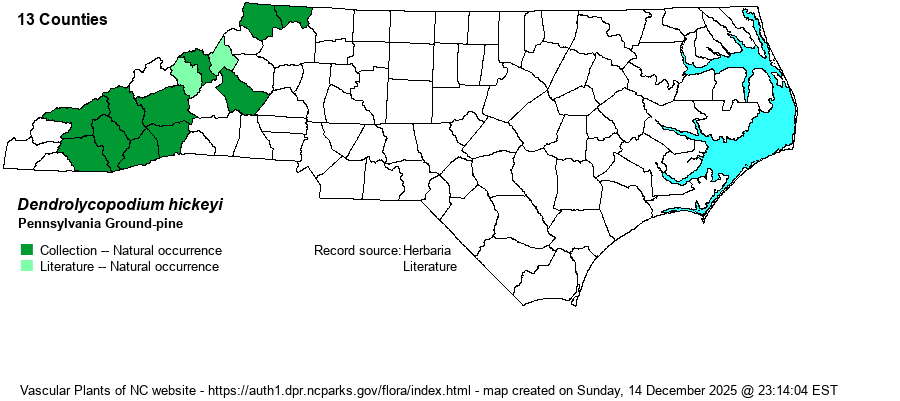| Section 1 » Family Lycopodiaceae |
Show/Hide Synonym
| taxonName | relationship | relatedTaxonName | relatedTaxonRefText | relComments |
|---|
|
|
|
|
| Dendrolycopodium hickeyi | < | Lycopodium obscurum var. dendroideum | Fernald (1950) | | | Dendrolycopodium hickeyi | < | Lycopodium obscurum var. dendroideum | Gleason (1952) | | | Dendrolycopodium hickeyi | < | Lycopodium obscurum var. dendroideum | | | | Dendrolycopodium hickeyi | < | Lycopodium obscurum var. dendroideum | Radford, Ahles, and Bell (1968) | | | Dendrolycopodium hickeyi | < | Lycopodium obscurum var. dendroideum | Flora of West Virginia | | | Dendrolycopodium hickeyi | = | Lycopodium hickeyi | Flora of North America (1993b, 1997, 2000, 2002a, 2002b, 2003a, 2004b, 2005, 2006a, 2006b, 2006c, 2007a, 2009, 2010) | | | Dendrolycopodium hickeyi | = | Lycopodium hickeyi | Kartesz (1999) | | | Dendrolycopodium hickeyi | = | Lycopodium hickeyi | | | | Dendrolycopodium hickeyi | = | Lycopodium obscurum var. isophyllum | Wofford (1989) | | | Dendrolycopodium hickeyi | < | Lycopodium obscurum | Gleason and Cronquist (1991) | | | Source: Weakley's Flora |
|
| Author | (W.H. Wagner, Beitel, & R.C. Moran) A. Haines | |
| Distribution | Present over most of the mountains, but as this is a quite difficult species to identify, the total range there is uncertain. It might be truly absent from the extreme southwestern counties.
This is a Northern species, ranging from eastern Canada south to New England and MN, and southward in the Appalachians to western NC and eastern TN. | |
| Abundance | Apparently rare to locally uncommon, at least at high elevations; perhaps absent in the southwesternmost counties. The NCNHP database contains 19 records, of which most are extant, but with little information on population sizes for most of them. This is a Significantly Rare species, and the "?" on the State Rank is certainly warranted. | |
| Habitat | This is a species of high elevations, mainly at heath balds and grassy balds. It also grows in open, acidic forests, as well as bog margins, but always in cool to cold microclimates in NC. | |
| Phenology | Fruits from July to September. | |
| Identification | This is a Northern species that probably will be difficult for most biologists to separate from the common D. obscurum, though any "ground-pine" at high elevations, especially in exposed sites, should be collected or studied for this rarity or at least poorly known species. Like that species, it has several vertical branches that give rise to a number of branchlets, many of them in horizontal layers. The leaves are evergreen, densely packed around each branchlet, and ascending. The strobili are at the ends of several of the branches, about 1.5 inches long, and quite erect, pale green in color -- lighter in color than the rich green of the leaves. This species (formerly included within D. obscurum) has the leaves somewhat more closely appressed or angled upward and the spread of the branchlet (with leaves) is about 3.5-6 mm wide, as opposed to 6-9 mm wide in D. obscurum. Also, the abaxial (lower) leaves of the horizontal branchlets are about the same length as the lateral leaves in D. hickeyi, whereas those leaves in D. obscurum are only half to two-thirds the length of the lateral leaves. D. obscurum is quite common in the mountains, more often growing in low to middle elevations and inside acidic, coniferous and mixed forests. You may need to check keys for further separation, but in general, the branchlets of this species are more rounded, as all leaves are about the same size; and branchlets of D. obscurum are more flattened in shape. | |
| Taxonomic Comments | The species has been called Lycopodium hickeyi in some references. Older ones included it within D. obscurum (or L. obscurum), typically named as L. obscurum var. isophyllum.
| |
| Other Common Name(s) | Hickey's Tree-clubmoss, Hickey's Clubmoss, Pennsylvania Clubmoss. More references use "Clubmoss" than "Ground-Pine". However, as species in the genus Lycopodium were generally named as "clubmoss", species in the genus Dendrolycopodium are now best referred to as ground-pines or tree-clubmosses. All three species in NC are quite similar, and thus all need to have the same group name, with the editors using "ground-pine" for now. | |
| State Rank | S2? | |
| Global Rank | G5 | |
| State Status | SR-P | |
| US Status | | |
| USACE-agcp | | |
| USACE-emp | | |

